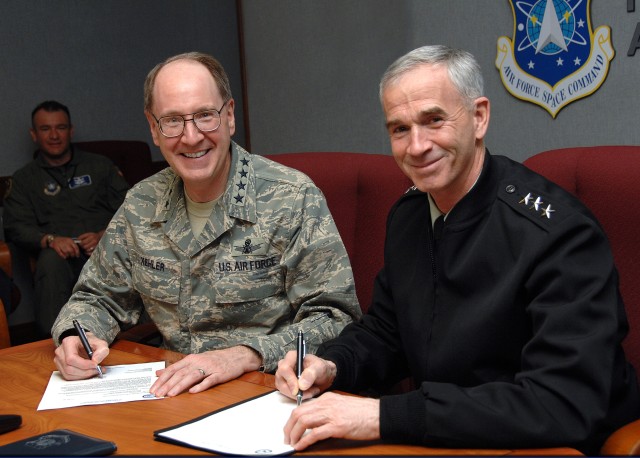
A new satellite is circling the Earth. The Wideband Global SATCOM (Satellite Communications) satellite is a reality. This is the most powerful communications satellite in the Department of Defense inventory. It is the first of six satellites that will take over long-haul communications from the legacy constellation, the Defense Satellite Communications System. WGS went operational April 15.
Many years ago, when a new communications satellite was needed, the Air Force would build it, launch it and then other services could use the capabilities it provided. Today it is a joint effort. The warfighting community, including the Army Space and Missile Defense Command/Army Forces Strategic Command at Redstone Arsenal, Ala., get together and define the requirements for today and into the future and then the engineers go to work to design a capability that will support the warfighter for the estimated life expectancy of the satellite.
WGS is an example of such cooperation. Originally planned as a gap filler between the DSCS system and a more capable system, it evolved to become the new system. Each WGS is more capable than the entire nine-satellite DSCS constellation now in operation. The six-satellite WGS constellation will be operational sometime in 2012.
The joint aspect of this satellite constellation is similar to the way the DSCS constellation operates. Air Force Space Command is charged with "flying" the WGS satellite through the 3rd Space Operations Squadron located at Schriever Air Force Base, Colo. The 3rd SOPS continuously monitors and maintains satellite health by performing daily telemetry, tracking and commanding functions.
SMDC/ARSTRAT's 53rd Signal Battalion, headquartered in Colorado Springs, Colo., operates the payload from global locations in direct support of the warfighting community and other government agencies throughout the DoD. The battalion is the Army's only satellite control unit and manages, plans, and controls payloads to assure the reliability of the communications they provide to tactical and strategic warfighters.
Peter Stauffer, director of the Wideband SATCOM Division at SMDC/ARSTRAT, spoke about the difference WGS payload capabilities will make to the warfighter.
"WGS provides a quantum leap in capabilities -- not only in throughput but in operational flexibility," he said. "The ability for the warfighter to exchange information faster using higher data rates, and more efficiently, with the ability to reach different locations simultaneously is part of the inherent capability of WGS. Data, full motion video, maps, voice and imagery will be received and transmitted by warfighters at all levels -- tactical, operational and strategic."
Stauffer also addressed the difference in operations for the Army units operating the payload.
"Network planning and payload operations for WGS are more complicated than with the DSCS system," Stauffer added. "The expertise and dedication of our people in the SATCOM Support Centers and 53rd Signal Battalion is going to make the difference. They understand the importance of this mission and they will make it happen."
The Joint operation of this satellite is a pure example of Army and Air Force warfighting commands supporting the entire warfighter community.

Social Sharing